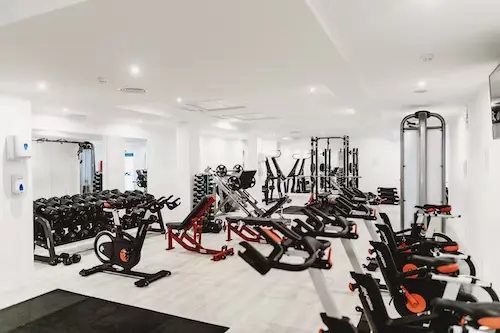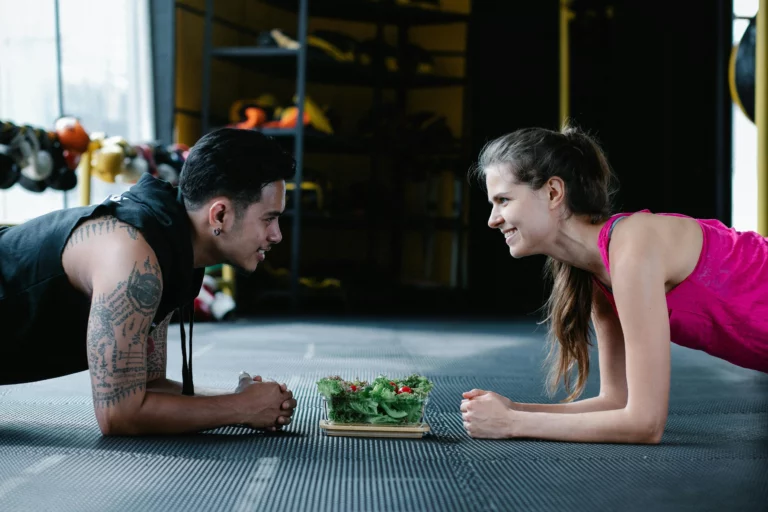Why Is Exercise Important For Wellness?
What Does Being “Well” Really Mean?
Being “well” means having complete health and happiness in both your mind and body. Wellness looks at the full picture of your lifestyle habits, relationships, purpose, and environment – not just avoiding illness.
When all the different dimensions of your life feel balanced, you experience greater life satisfaction. This fuels positive emotions, resilience in stress, and deeper connections. Regular exercise plays a huge role in cultivating well-rounded health.
How Exercise Supports Whole-Person Wellness
Physical activity training makes most people immediately think about fitness level, weight management, and cardiovascular health. But clear science now proves exercise equally boosts brain health, emotional regulation, and healthy aging too.
Research links routine workouts with these whole-life benefits:
- Lower rates of depression, anxiety and dementia
- Better academic and job performance
- More satisfying relationships
- Greater life purpose and happiness
- Delayed brain aging and mortality risk
Keep reading to explore exactly why…
The Mental Health Benefits of Exercise
Chronic stress today overwhelms millions physically, mentally, and emotionally. Sadness, loneliness, irritability, worry, and panic threaten everyone at times. How does sweating help here? What happens in bodies and minds when we walk, dance, or pedal life’s stresses away?
Exercise Releases “Feel Good” Chemicals
Working out pumps muscles demanding more fuel and oxygen carried by increased blood flow. As you pick up pace, your brain coordinates breathing and heartbeat adjustments through the nervous system. These activating signals reach the brain’s pituitary gland triggering the release of endorphins.
Known as the brain’s “feel good” chemicals, endorphins both relieve physical discomfort and provoke euphoria experienced as a “runner’s high”. Simultaneously, exercised muscles release other chemicals enhancing mood like serotonin managing emotions, appetite, and sleep quality or cannabinoids behind marijuana’s infamous relaxation effects.
The Anxiety and Depression Antidote
Over 15 million Americans suffer depressive disorders with even more reporting moderate to high anxiety levels. Sadness and chronic worrying often concentrate among vulnerable groups like trauma survivors or marginalized communities. Exercise provides effective medicine here.
Studies consistently demonstrate just 5 key lifestyle habits including routine and moderate activity slash depression likelihood by over 80% alone! Combining consistent mindfulness meditation, community engagement, healthy meals, and adequate sleep converts high-risk people into the lowest depression percentile.
But what makes breaking a sweat so individually protective? Physically active people simply ruminate less. Exercise distraction interrupts repetitive negative thought loops fueling helplessness. You redirect focus onto movement sensations, athletic goals, or playfulness. Destructively rehashing problems stalls once concentration anchors positively.
Active bodies also better manage the stress hormone cortisol keeping anxiety from spiraling. One week of maintaining elevated activity shrinks anxiety sensitivity by over 15% compared to inactive peers according to data. As exercise-induced euphoria sinks in, life feels far less emotionally overwhelming.
Why Exercising Outside Boosts Mental Health Best
Have you ever felt refreshed after hiking through nature or playing sports outside? Doctors now prescribe outdoor activity to treat anxiety, addiction, trauma-related concentration loss, and other cognitive conditions. Science confirms natural environments uniquely restore mental health.
The key reason involves how living elements constantly engage our senses randomly versus manufactured spaces. Wind-rustling trees, fragrant gardens, chirping birds, bubbling creeks and shifting sunlight always refocus wandering minds. Our brains crave sensory surprises lowering mental guards. Where ruminating falters, insight thrives.
Additionally, negatively ionized air circulating naturally significantly elevates mood through enhanced blood flow while decreasing inflammation. Manmade interior spaces trap stagnant positively charged air aggravating allergies, headaches, and insomnia. Exercising outside bathes bodies in healthy negative ions while boosting vital mental clarity.
So escape screens regularly to exercise immersed in nature’s vibrant therapy and fortify your whole wellness!
Why Cardio Matters
Virtually all physician groups from cardiac health experts, to mental health professionals, to healthy aging advocates now proclaim cardiovascular exercise’s unmatched abilities to sustain well-being across adulthood. Let’s break down cardio’s head-to-toe benefits supporting this bold declaration.
Heart and Lung Health
Cardio workouts improve stamina, lung function, and heart efficiency so oxygen circulates faster empowering you to take daily tasks and recreational activities in stride without tapping reserves. Strengthened respiration and circulation also prevent myriad common illnesses down the road.
As exercising spike heart rates, the heart muscle expands capacity through enlarged left ventricles and thicker walls over time. Healthy hearts pump greater blood volume using less effort. Lungs likewise grow additional capillary beds improving oxygen diffusion abilities. Clinical data shows routine cardio lowers mortality across all weight levels by slashing heart disease, diabetes, stroke and cancer risks.
Immune System Booster
Can infrequent moderate cardio sessions help you catch fewer colds? Definitely according to startling research revealing even occasional 20-minute jogs slash upper respiratory infections risk a whopping 30% over inactive peers. For avid athletes exercising over 30 hours weekly, the common cold likelihood plummets an incredible 50%!
Here’s why. Each workout floods previously idle immune cells into blood circulation hunting pathogens and jumpstarting prevention mechanisms. Consistency matters too – taking regular days off reverses immunity gains. So stick to frequent cardio training for amplified protection against illnesses jeopardizing productivity, fun and well-being.
Energy Level Surge
Feeling perpetually exhausted by noon relegates far too many adults to functioning below their brilliance. Deep fatigue vainly combatted with caffeine rollercoasters drains cognitive sharpness. Thankfully cardio consistently boosts natural energy when incorporated properly.
Initially, aerobic activity indeed expends substantial calories and bodily resources powering movement. However, upon resting post-cardio cellular oxygen utilization capacity expands causing more available energy despite consuming identical foods and sleeping equal hours. You awaken feeling truly restored without mid-day slumps.
Your body essentially adapts through mitochondrial biogenesis – growing fresh mitochondria subcellular oxygen processing organelles. More mitochondrial power plants convert blood glucose and oxygen into mobile ATP energy faster. Everyone wins with heightened reserves!
Better Blood Sugar Balance
Roughly 1 in 5 adults currently suffer insulin resistance preventing efficient fuel metabolism gradually cultivating fatty liver disease, hypertension, stroke, and diabetes driving premature death. Sedentary habits largely explain ballooning prediabetic cases. Activating muscle movement returns blood sugar control closer to ideal wellness.
Contracting skeletal muscles feast on glucose for ATP fuel draining excess blood sugars disposed through sweat, urine, and feces. Less sugar circulating means less insulin is required to keep equilibrium. Cells restore insulin sensitivity reversing metabolic disorder.
This powerful blood sugar balancing forces the body to increasingly metabolize fat stores over blood glucose for muscular fuel through respiration. Accelerating calorie burn combined with lower insulin levels reinstates a healthy weight conducive to wellbeing.
Exercise Benefits That Extend Life
Aging brings declining vigor, strength, reaction times, balance, and mental sharpness worrying people anxious to preserve independence, health, and purpose. While appearing inevitable, extensive research proves consistent exercise essentially slows human aging.
Preserving Brain Health and Cognitive Ability
Worried about developing dementia later in life like one-third of seniors? Regular cardio exercise halves cognitive decline rates in senior populations according to expansive Lancet research analyzing over 1.5 million collective individual records across 15 past investigations. Memory loss fears dissolve when people simply walk often.
Studies also found older adults performing moderate cardio exercise for one year expanded their hippocampus brain region volumes by 2% resulting in improved spatial and verbal memory acquisition. Control groups following only toning workouts saw hippocampus shrinkage consistent with normal senior aging. Cardiovascular training beats back dementia likelihood.
Beyond combatting Alzheimer’s disease, physically active older adults better retain attention, multitasking speed, and mental flexibility allowing sustained independence and daily functioning. Starting aerobic activity even into your 70s improves executive functioning crisis response and daily life conduct.
Preserving both cognitive health and physical mobility into later decades depends enormously on reaping cardiovascular exercise benefits spanning from enhanced brain neuroplasticity, vascularity, special synaptic neuron connectivity, and inflammation regulation credited for sharper mental functioning given matched aging.
Attenuated Cellular Aging
Have you wondered if exercise could slow biological aging itself? Emerging cell science provides compelling evidence affirming routine aerobics rewind “epigenetic clocks” measuring cellular aging!
Specialized biomarkers within genetic expression called methyl groups accumulate over time byging chromosomal DNA similar to wrinkles signalling antiquity externally. UCSF researchers found participants doing over 30 minutes daily moderate cardio added 200-300 extra youthful days avoiding methyl group accrual versus sedentary peers after just 18 months exercising.
Moreover, longer sustained cardio habits near halved muscle tissue methyl group burdens indicate dramatically younger muscle gene activity. Consequently, 70-year-olds meeting physical activity guidelines often carry far lower fatal disease and mortality risk profiles than biologically elder inactive 65-year-olds based on cellular aging calculations.
This astonishing discovery means choosing frequent aerobics defies genetic destiny. Mitochondria replenishing, blood sugar stabilizing, brain boosting and quicker reaction times all translate into healthier longer lifespans ripe with well-being through advanced ages.
Stronger Bones Without Prescriptions
Osteoporosis threatening bone fragility worries everyone approaching older adulthood. Directly strengthening skeletal structure remains impossible past puberty when the majority of bone mass solidifies. However strategic exercise still greatly supports healthy bone remodeling reducing osteoporosis likelihood.
Weight lifting spotlighted for building burly muscles rightfully deserves equal fame bolstering skeletal endurance essential for resilient bone health. Mechanical loading forces bones to continually renew mineral density and micro-architecture through proportional modeling and remodeling cell processes influenced heavily by muscular pull.
Without adequate muscular loading from both cardio activity and resistance training, bone strength steadily declines as adults age — especially within women experiencing menopause’s hormonal transitions accelerating bone loss. But clinically any sex-engaging complex, impactful weight-bearing exercise despite modest intensity signals ongoing bone fortification delaying osteopenia and osteoporosis.
Ultimately aligning nutrition, stress levels, medical stats, and age with personalized activity plans makes achieving enviable bone strength in older ages easily achievable. Making wellness a priority promises freedom facing a few fractures.
Why Strength Training Complements Cardio
While machines isolating muscle groups sufficed decades ago before complex exercise science emerged, today’s expanding insights into anatomy, kinesiology, and sports medicine confirm more comprehensive full-body training optimizes well-being as we age. Let’s delve into key reasons why adding multi-joint strength sessions enhances health beyond isolated cardio.
Building Confident Capable Bodies
Progressing gym class calisthenics into gratifying feats like holding fierce yoga poses, paddling distant shores, or hoisting bundled grandchildren all require well-conditioned functional muscles reinforcing proper movement. Strength training specifically hones coordinated mobility.
Without practicing integrated shoulder, core, and hip stability, people often injure easily from overexertion or falls from midlife onwards. Mastering activation techniques and moderate resistance builds essential balance, alignment, and body awareness keeping aging adults injury-free.
Structured strength sequences also establish safe movement foundations to amplify athleticism in sports, dance, and recreational play with kids. You demonstrate powerful abilities blazing trails for upcoming generations.
Accelerated Cardio Gains
Sure marathon runners log impressive mileage weekly. However recent revelations show pairing focused heavy strength sessions with high-intensity cardio intervals elicits the greatest endurance, VO2 max, and calorie burn levels. This hybrid training formula maximizes aerobic capacity and fat loss.
The research found men combining multi-joint lifts with battling rope drills and treadmill sprints lost double the fat following limited cardio-only programs over identical periods. Even resting metabolic levels spiked further indicating enhanced mitochondrial ATP energy production. Leaning down faster inspires everyone to sustain fitness habits reaping wellness.
Additionally, lifting prevents metabolism from slowing inevitably when drastic low-calorie cardio-centric plans stall fat loss plateaus. Countering adaptation through ongoing strength progress allows dropping multiple clothing sizes without offensive starvation tactics or rebound weight gain. Gain strength to unlock cardio as the key to leanness.
Muscle Retention Resisting Metabolic Slowing
People striving for calorie burn often overlook frustrating muscle wasting and sabotaging weight loss goals. The more muscle you carry through balanced strength programs, the easier maintain a fast metabolism. This helps avoid yo-yo weight fluctuations and insulin resistance.
Hitting step goals cannot prevent hormonal shifts from depleting aging bodies of 3-5 pounds of lean mass annually absent resistance training. But cleverly structuring easy muscle-stimulating exercises minimizes muscle loss. Seniors still synthesizing some new muscle given proper mechanical signaling enjoy higher quality lives over frail inactive peers.
Remember lean muscle tissue requires 30-50 daily calories per pound to merely exist. So dropping 10 pounds of muscle gradually slows metabolism by 300-500 calories, meaning gaining equal fat and eating identically requires alarmingly nominal surplus fuel. Fight unwanted fluff through ongoing strength training!
Creating An Effective Wellness Exercise Routine
Hopefully learning all the science-backed wellness benefits flowing from regular workouts, you feel inspired to exercise more consistently, whether beginner or experienced! Optimizing sustainable regimens aligned with your unique lifestyle, health stats, and goals takes some strategic reflection first.
Assessing Realistic Baselines
Creating routines doomed to fail stems from arbitrarily assigning daily targets not accounting for current fitness levels, schedule feasibility, or acknowledging areas needing work for progression. Establish realistic baselines through these steps:
First, take stock of typical weekly exercise habits currently – what activities do you do, for how long, and how often? Be honest but non-judgmental. This is your starting point for gradual building versus drastic overhaul vulnerable to quick abandonment when life gets busy or motivation dips temporarily.
Next reflect on whether certain zones need focused development like cardio capacity, core strength, balance challenges, or recovery time to prevent unhealthy strain from inviting injury which derails consistency. Scan your medical history to select modalities well-suited for mitigating risks through your doctor’s guidance if managing illness. No exercise compromising safety cuts.
Finally consider average energy levels throughout normal workdays and family commitments. Which blocks permit inserting fitness like lunch breaks, before/after standard shifts, or leveraging commute time walking/biking further? Cluster exercises when feeling freshest and strongest. Scheduling workouts sporadically whenever the mood strikes usually backfires through unreliable follow-through. Evaluate timing conducive to establishing habitual wellness routines. With insightful planning, the last fitness success awaits!
Mixing Up Cardio For Enhanced Results
Cardio training entrenched in boring routines unfortunately activates little mental engagement deteriorating adherence over time. But injecting assorted cardio formats like elliptical circuits, tennis, biking through novel routes, dancing wildly, jump roping, or outdoor obstacle course races carries built-in intrinsically motivated focus promising more enjoyment long haul.
Varying cardio mode additionally recruits new complementary lower body stabilizer subgroups when striding over unpredictable trail terrain versus familiar treadmill belts. Shifting between steady state low intensity to challenging interval days sidesteps fitness plateaus also via manipulating heart rate patterns and energy pathways.
Sprinkle weekly cardio workouts between equipment like rowing machines, AMTs, stair masters, and standard runs. Add P90X or Beachbody on Demand dance videos streaming unlimited content energetically boosting mood with laughter and nostalgia! If something no longer captivates your spirit, joyfully move on to the next! Wellness requires freedom to playfully chase peak vitality.
Balancing Strength For All Needs
Whether training hardcore for explosive powerlifting peak performance, modifying special populations’ mobility issues, or simply maintaining baseline strength to assist aging adults’ mobility, appropriately planning strength programming variables makes genuine progress inevitable. But distinguishing essential factors for accomplishing objectives gets obscured often without guidance.
Here’s an easy blueprint aligning essential strength training components to your special needs for sculpting capable resilient physiques serving wellness:
For building mass quickly – Prioritize moderate (6-12 reps) lifting challenging weights through a full range of motions targeting major muscle groups 2-4 days weekly interspersed with ample calorie surplus eating and rest.
For maximizing athletic quickness and reactive power – Shift focus to lower rep plyometric jumping complexes on nonconsecutive days blended with Olympic explosive lifts like cleans before games plus intentional speed and agility drills.
For boosting bone density against osteoporosis – Include brief high-impact weight-bearing exercises like bounding box jumps alongside moderate rep lower body compound lifts using kettlebells or barbells for skin-loading bones 2-3x weekly.
For assisting physical therapy injury rehabilitation – Isolate targeted tension on compromised stabilizers through high repetition direct isolation lifts within pain-free ranges of motion guided under licensed professionals.
For maintaining seniors’ balance/fall prevention – Practice slow controlled movements on instability surfaces like wobble boards alongside Pilates ring core activation challenging control and mobility.
The right stimulus applied through personalized strength training frameworks unleashes incredible transformation related to wellness goals when aligned with sound nutritional support. Seek expertise in creating your plan.
Allowing Proper Recovery
While brisk walks provide gentle active recovery, aggressive extended endurance training, intensive plyometric sessions or max strength exertions necessitate programmed rest permitting full muscular and nervous system regeneration critical for peak performance.
Insufficient recovery ruins upcoming workouts and hastens burnout through unchecked inflammation and spiking cortisol hormones. Everyone requires downtime, especially aging populations more injury prone undergoing hormone shifts.
Strategically balancing training days with easier active movement, passive rest or massage therapy ensures maximal rate strength and physique improvements continue accelerating properly. Remain patient celebrating small muscular and cardiovascular milestones through balanced efforts. Lasting vibrancy comes to those valuing restfulness too.
Conclusion
In summary the tremendous mental health benefits, cardiovascular disease risk reduction, anti-aging effects, and added strength flowing from regular exercise prove foundational for sustaining well-rounded health and happiness throughout life no matter genetic tendencies or past diagnoses.
Assessing current baselines объектively and intentionally programming varied activities into weekly routines markedly multiplies physiological resilience and emotional thriving long term. Surprisingly minimal daily movement produces radical wellness transformation over decades. Simply rise and walk gently with awareness most days without forgetting to rest. Right paths unfold beneath every mindful step towards whole health.
Check More Articles






